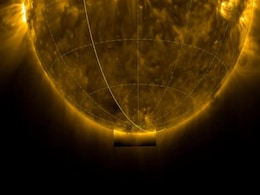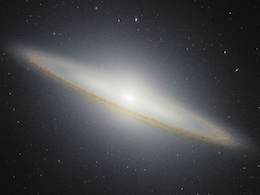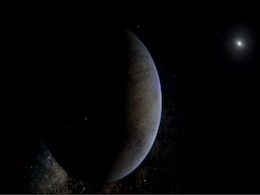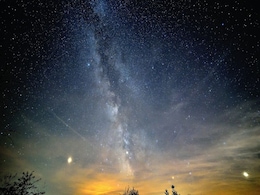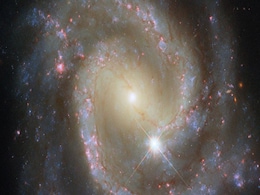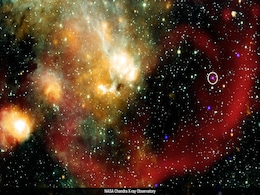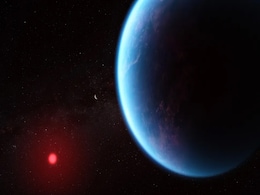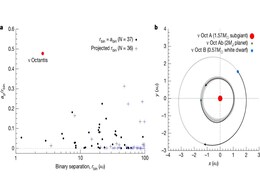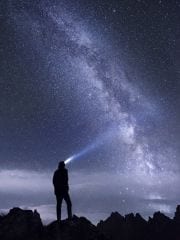Astronomy
- All
- News
- Videos
- Web Stories
-

Hubble Finds Cosmic Dust Coating Uranus’ Moons, Not Radiation Scars
- Thursday June 12, 2025
- Written by Gadgets 360 Staff
New Hubble Space Telescope observations have upended decades of expectations about Uranus’ moons. Scientists once thought the planet’s magnetic field darkened their backsides with radiation, but the latest data shows Titania and Oberon are collecting space dust on their leading sides instead. This “cosmic bug splatter” effect suggests dust ...
-
 www.gadgets360.com
www.gadgets360.com
-

Solar Orbiter Captures First-Ever Close-Up of Sun’s South Pole, Revealing Magnetic Field Chaos
- Thursday June 12, 2025
- Written by Gadgets 360 Staff
In a historic first, ESA’s Solar Orbiter has imaged the Sun’s elusive south pole, exposing a tangle of magnetic fields and solar winds. The mission marks a major leap in understanding space weather and the 11-year solar cycle that influences Earth’s environment.
-
 www.gadgets360.com
www.gadgets360.com
-

Where Is The Centre Of The Universe?
- Wednesday June 11, 2025
- World News | The Conversation
Published in 1915, and already widely accepted worldwide by physicists and mathematicians, the theory assumed the universe was static unchanging, unmoving and immutable.
-
 www.ndtv.com
www.ndtv.com
-

NASA’s Chandra Spots Unexpectedly Strong Jet from Distant Black Hole at Cosmic Noon
- Wednesday June 11, 2025
- Written by Gadgets 360 Staff
NASA’s Chandra telescope has spotted two powerful black hole jets from over 11.6 billion light-years away. Detected during the universe’s cosmic noon, these jets reveal rare high-speed behaviour boosted by Big Bang remnants. The findings, which factor in relativistic effects, shed new light on early black hole growth and will be published in Th...
-
 www.gadgets360.com
www.gadgets360.com
-

ASKAP Telescope Discovers 15 Massive Giant Radio Galaxies, Largest Objects in the Known Universe
- Wednesday June 11, 2025
- Written by Gadgets 360 Staff
Astronomers using the ASKAP telescope have discovered 15 Giant Radio Galaxies, including one stretching 12.4 million light-years. These vast structures offer new clues about black hole life cycles and jet activity. The unprecedented detail of ASKAP’s deep-sky imaging reveals both ancient and recent radio lobes, opening a new chapter in understand...
-
 www.gadgets360.com
www.gadgets360.com
-

James Webb Space Telescope Captures Stunning Near-Infrared View of Sombrero Galaxy
- Tuesday June 10, 2025
- Written by Gadgets 360 Staff
NASA has unveiled a spectacular near-infrared image of the Sombrero Galaxy taken by the James Webb Space Telescope. This fresh perspective showcases the glowing stellar bulge and dust distribution, deepening our understanding of how galaxies evolve over time.
-
 www.gadgets360.com
www.gadgets360.com
-

Astronomers Discover Most Powerful Cosmic Explosions Since the Big Bang
- Saturday June 7, 2025
- Written by Gadgets 360 Staff
Astronomers have discovered extreme nuclear transients — rare and powerful explosions caused by stars being torn apart by supermassive black holes. These events, brighter and longer-lasting than supernovae, were observed using data from Gaia and ZTF. As the most energetic cosmic outbursts since the Big Bang, they offer valuable insights into blac...
-
 www.gadgets360.com
www.gadgets360.com
-

New Dwarf Planet Discovery Challenges Planet Nine Hypothesis
- Monday June 2, 2025
- Written by Gadgets 360 Staff
The discovery of a potential dwarf planet, 2017 OF201, in the farthest reaches of the solar system is reshaping our understanding of space. With a highly elongated orbit and large size, it contradicts the Planet Nine hypothesis, which predicted orbital clustering among distant objects. This finding not only questions the existence of a ninth planet...
-
 www.gadgets360.com
www.gadgets360.com
-

Brightest Planets in June’s Night Sky: How and When to See Mercury, Venus, Mars and Saturn
- Monday June 2, 2025
- Written by Gadgets 360 Staff
Skywatchers can spot Mercury, Venus, Mars, and Saturn in prime June skies during dusk and dawn hours. With Mercury at its best visibility, Mars pairing with Regulus, and Venus and Saturn rising before sunrise, celestial highlights abound. A crescent moon joins Mars on June 29, making this month ideal for skywatching and astrophotography.
-
 www.gadgets360.com
www.gadgets360.com
-

Hubble Spots Isolated Barred Spiral Galaxy That’s Secretly Part of a Cosmic Duo
- Monday June 2, 2025
- Written by Gadgets 360 Staff
Hubble’s latest view features NGC 3507, a barred spiral galaxy in Leo, secretly traveling with its companion NGC 3501. Though only one is captured in the frame, both are spiral galaxies seen from different angles, offering a dual cosmic perspective. The image also reveals nearby stars and faint, distant galaxies across the backdrop of deep space.
-
 www.gadgets360.com
www.gadgets360.com
-

Astronomers Baffled By Mysterious Object Emitting X-Rays And Radio Waves In Milky Way
- Friday May 30, 2025
- Science | Edited by Nikhil Pandey
The object, designated ASKAP J1832-0911, is located 15,000 light-years away and its nature is currently unknown, though it could be a highly magnetized dead star or something entirely new.
-
 www.ndtv.com
www.ndtv.com
-

3 'City-Killer' Asteroids Could Strike Earth In Weeks, Say Scientists
- Thursday May 29, 2025
- Science | Edited by Anjali Thakur
The study highlights the threat posed by three space rocks-named 2020 SB, 524522, and 2002 CL1-which currently share an orbit with Venus.
-
 www.ndtv.com
www.ndtv.com
-

New Analysis Weakens Claims of Life on Distant Exoplanet K2-18b
- Thursday May 29, 2025
- Written by Gadgets 360 Staff
A new study led by University of Chicago researchers has reanalyzed James Webb Space Telescope data and found weaker evidence for potential biosignatures on exoplanet K2-18b. Earlier reports had suggested the presence of dimethyl sulfide (DMS), a chemical associated with marine life on Earth. However, the latest analysis reveals that the signals ar...
-
 www.gadgets360.com
www.gadgets360.com
-

Strange Planet Confirmed in Binary Star System Nu Octantis
- Wednesday May 28, 2025
- Written by Gadgets 360 Staff
Astronomers have confirmed the existence of a massive planet in the Nu Octantis binary star system, first suspected in 2004. Using advanced tools like the HARPS spectrograph, researchers found that the planet orbits in the opposite direction of one of the stars—a retrograde motion that keeps the system stable. The discovery of a white dwarf in th...
-
 www.gadgets360.com
www.gadgets360.com
-

Astronomers Spot Nearly Perfect Supernova Remnant of Unknown Size and Distance
- Wednesday May 28, 2025
- Written by Gadgets 360 Staff
Astronomers have spotted a nearly perfect spherical supernova remnant named Telios on the Milky Way’s outskirts. With its low brightness and unknown distance, Telios defies standard models of cosmic remnants and may signal a rare Type Ia supernova. Its symmetry makes it one of the most intriguing galactic remnants ever recorded.
-
 www.gadgets360.com
www.gadgets360.com
-

Hubble Finds Cosmic Dust Coating Uranus’ Moons, Not Radiation Scars
- Thursday June 12, 2025
- Written by Gadgets 360 Staff
New Hubble Space Telescope observations have upended decades of expectations about Uranus’ moons. Scientists once thought the planet’s magnetic field darkened their backsides with radiation, but the latest data shows Titania and Oberon are collecting space dust on their leading sides instead. This “cosmic bug splatter” effect suggests dust ...
-
 www.gadgets360.com
www.gadgets360.com
-

Solar Orbiter Captures First-Ever Close-Up of Sun’s South Pole, Revealing Magnetic Field Chaos
- Thursday June 12, 2025
- Written by Gadgets 360 Staff
In a historic first, ESA’s Solar Orbiter has imaged the Sun’s elusive south pole, exposing a tangle of magnetic fields and solar winds. The mission marks a major leap in understanding space weather and the 11-year solar cycle that influences Earth’s environment.
-
 www.gadgets360.com
www.gadgets360.com
-

Where Is The Centre Of The Universe?
- Wednesday June 11, 2025
- World News | The Conversation
Published in 1915, and already widely accepted worldwide by physicists and mathematicians, the theory assumed the universe was static unchanging, unmoving and immutable.
-
 www.ndtv.com
www.ndtv.com
-

NASA’s Chandra Spots Unexpectedly Strong Jet from Distant Black Hole at Cosmic Noon
- Wednesday June 11, 2025
- Written by Gadgets 360 Staff
NASA’s Chandra telescope has spotted two powerful black hole jets from over 11.6 billion light-years away. Detected during the universe’s cosmic noon, these jets reveal rare high-speed behaviour boosted by Big Bang remnants. The findings, which factor in relativistic effects, shed new light on early black hole growth and will be published in Th...
-
 www.gadgets360.com
www.gadgets360.com
-

ASKAP Telescope Discovers 15 Massive Giant Radio Galaxies, Largest Objects in the Known Universe
- Wednesday June 11, 2025
- Written by Gadgets 360 Staff
Astronomers using the ASKAP telescope have discovered 15 Giant Radio Galaxies, including one stretching 12.4 million light-years. These vast structures offer new clues about black hole life cycles and jet activity. The unprecedented detail of ASKAP’s deep-sky imaging reveals both ancient and recent radio lobes, opening a new chapter in understand...
-
 www.gadgets360.com
www.gadgets360.com
-

James Webb Space Telescope Captures Stunning Near-Infrared View of Sombrero Galaxy
- Tuesday June 10, 2025
- Written by Gadgets 360 Staff
NASA has unveiled a spectacular near-infrared image of the Sombrero Galaxy taken by the James Webb Space Telescope. This fresh perspective showcases the glowing stellar bulge and dust distribution, deepening our understanding of how galaxies evolve over time.
-
 www.gadgets360.com
www.gadgets360.com
-

Astronomers Discover Most Powerful Cosmic Explosions Since the Big Bang
- Saturday June 7, 2025
- Written by Gadgets 360 Staff
Astronomers have discovered extreme nuclear transients — rare and powerful explosions caused by stars being torn apart by supermassive black holes. These events, brighter and longer-lasting than supernovae, were observed using data from Gaia and ZTF. As the most energetic cosmic outbursts since the Big Bang, they offer valuable insights into blac...
-
 www.gadgets360.com
www.gadgets360.com
-

New Dwarf Planet Discovery Challenges Planet Nine Hypothesis
- Monday June 2, 2025
- Written by Gadgets 360 Staff
The discovery of a potential dwarf planet, 2017 OF201, in the farthest reaches of the solar system is reshaping our understanding of space. With a highly elongated orbit and large size, it contradicts the Planet Nine hypothesis, which predicted orbital clustering among distant objects. This finding not only questions the existence of a ninth planet...
-
 www.gadgets360.com
www.gadgets360.com
-

Brightest Planets in June’s Night Sky: How and When to See Mercury, Venus, Mars and Saturn
- Monday June 2, 2025
- Written by Gadgets 360 Staff
Skywatchers can spot Mercury, Venus, Mars, and Saturn in prime June skies during dusk and dawn hours. With Mercury at its best visibility, Mars pairing with Regulus, and Venus and Saturn rising before sunrise, celestial highlights abound. A crescent moon joins Mars on June 29, making this month ideal for skywatching and astrophotography.
-
 www.gadgets360.com
www.gadgets360.com
-

Hubble Spots Isolated Barred Spiral Galaxy That’s Secretly Part of a Cosmic Duo
- Monday June 2, 2025
- Written by Gadgets 360 Staff
Hubble’s latest view features NGC 3507, a barred spiral galaxy in Leo, secretly traveling with its companion NGC 3501. Though only one is captured in the frame, both are spiral galaxies seen from different angles, offering a dual cosmic perspective. The image also reveals nearby stars and faint, distant galaxies across the backdrop of deep space.
-
 www.gadgets360.com
www.gadgets360.com
-

Astronomers Baffled By Mysterious Object Emitting X-Rays And Radio Waves In Milky Way
- Friday May 30, 2025
- Science | Edited by Nikhil Pandey
The object, designated ASKAP J1832-0911, is located 15,000 light-years away and its nature is currently unknown, though it could be a highly magnetized dead star or something entirely new.
-
 www.ndtv.com
www.ndtv.com
-

3 'City-Killer' Asteroids Could Strike Earth In Weeks, Say Scientists
- Thursday May 29, 2025
- Science | Edited by Anjali Thakur
The study highlights the threat posed by three space rocks-named 2020 SB, 524522, and 2002 CL1-which currently share an orbit with Venus.
-
 www.ndtv.com
www.ndtv.com
-

New Analysis Weakens Claims of Life on Distant Exoplanet K2-18b
- Thursday May 29, 2025
- Written by Gadgets 360 Staff
A new study led by University of Chicago researchers has reanalyzed James Webb Space Telescope data and found weaker evidence for potential biosignatures on exoplanet K2-18b. Earlier reports had suggested the presence of dimethyl sulfide (DMS), a chemical associated with marine life on Earth. However, the latest analysis reveals that the signals ar...
-
 www.gadgets360.com
www.gadgets360.com
-

Strange Planet Confirmed in Binary Star System Nu Octantis
- Wednesday May 28, 2025
- Written by Gadgets 360 Staff
Astronomers have confirmed the existence of a massive planet in the Nu Octantis binary star system, first suspected in 2004. Using advanced tools like the HARPS spectrograph, researchers found that the planet orbits in the opposite direction of one of the stars—a retrograde motion that keeps the system stable. The discovery of a white dwarf in th...
-
 www.gadgets360.com
www.gadgets360.com
-

Astronomers Spot Nearly Perfect Supernova Remnant of Unknown Size and Distance
- Wednesday May 28, 2025
- Written by Gadgets 360 Staff
Astronomers have spotted a nearly perfect spherical supernova remnant named Telios on the Milky Way’s outskirts. With its low brightness and unknown distance, Telios defies standard models of cosmic remnants and may signal a rare Type Ia supernova. Its symmetry makes it one of the most intriguing galactic remnants ever recorded.
-
 www.gadgets360.com
www.gadgets360.com


